
The Right Elbow
And The Golf Swing
All pictures were taken at Ocean Trails Golf Club, which is now Trump National Golf Club Los Angeles, in Rancho Palos Verdes, California.
Many golfers are told that the right elbow should be in a specific position at the end of the backswing, but this isn't necessarily true. The position of the right elbow can be vastly different depending on the swing type.
For instance, with the Ben Hogan swing, at the end of the backswing the right elbow should point down, be close to the body, and also be relatively close to the left elbow. With Jack Nicklaus's swing, the right elbow moves up and away from the body, what is called a "flying elbow", and there is a much wider gap between the left and right elbow. Obviously, both of these positions are correct even though they could hardly be more different.
One extremely important factor for golfers with a flying elbow is that during the transition from backswing to forward swing, the elbow has to move back in—more toward the left elbow—quickly so as not to get stuck out and also to flatten the swing, which became steep due to the elbow going out and lifting. Good players do this, but few amateurs do because they haven't learned to make this move and most instructors don't teach it, or if they try, don't teach it properly!
To make this "flying elbow" work, you'll need to find a way to get the elbow back in as you shift into the forward swing. Fred Couples transitions masterfully and he has more of a flying elbow than Nicklaus. It might be beneficial to watch some side videos of him swing and try to imitate.
For golfers with a flying elbow, be aware that letting the elbow get out tends to impede shoulder turn during the backswing. It is very important to make sure you're getting a full turn and if you find you aren't, you'll have to find a way to make it happen and practice enough to let the increased turn become a part of your swing. Watch video of young Nicklaus (mid-thirties and younger) hitting driver to see some real body movement—very impressive.
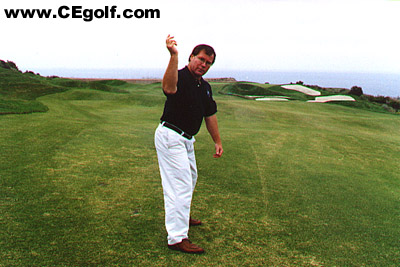
In the first picture, I am showing the downward orientation of the right arm that is important for both the Hogan and One Plane swing types. Because people are built differently there isn't any one exact position, but this is the general area.
With the right elbow in the position shown here, the right arm is free to hinge in order to keep the club in the correct swing plane, which by the way, will be a flatter plane since the low right arm will keep the hands lower.
Ben Hogan kept his right elbow closer to his body during the backswing than just about any other golfer (much more than I am showing here). This had the effect of forcing his body to do the work and helped synchronize the body and arms.
For those who try the Hogan swing, almost all feel that there is little available power when the elbow is kept in and down, but one must keep in mind that Hogan learned to use leverage and momentum, not muscle power—what I refer to as manipulation, to accelerate the club and generate incredible clubhead speed.
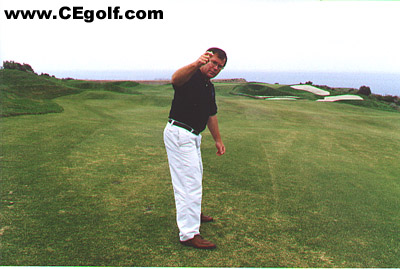
Picture two shows the right arm position of the typical golfer. The elbow is up, and note the angle of the forearm. The club can't stay in plane. Instead, the shaft will rise above plane and if the shaft gets close to parallel, it will point to the right of the target.
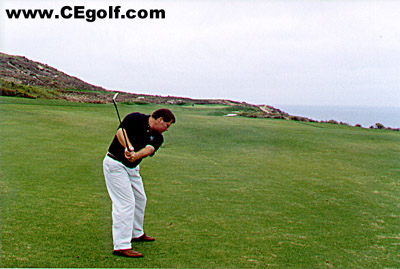
In picture three, the clubface is closed (backswing). Being too closed during the backswing is common and is a primary reason golfers have so much trouble getting the club into a good swing plane and it is also the cause of the elbow going up and out. Again, for certain swing types this motion is fine, but for swings where backswing plane is important, i.e., Hogan and One Plane swing types, it's a big problem!
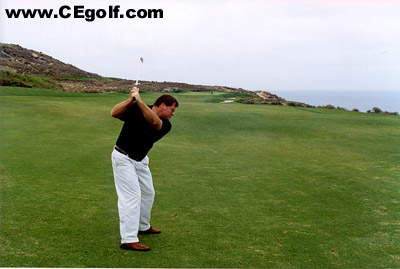
In picture four, the right elbow is up and you can see how steep the club is. Unless this position is corrected early in the forward swing, as good players do, I will be doomed to repeat the swing faults described on The Upright Golf Swing And The Block and The Steep Downswing pages.
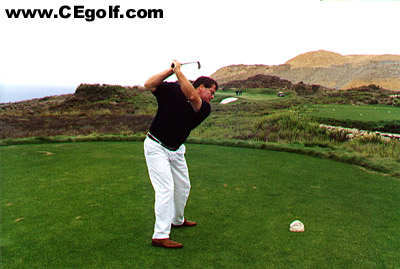
Pictures five (above) and six (below) are of the same extreme position, from two angles. The right arm is up even higher because I've gone back a little further. Notice the gap between the elbows. Looking at the front view you can see that allowing the right arm to lift tends to cause a reverse pivot, which is what happens when the the hips slide back sideways while the right elbow is forcing the upper body forward. Don't let this happen! It is the reverse pivot that is bad, not necessarily the elbow position. The elbow position can be fixed during the forward swing, the reverse pivot can't. Without the reverse pivot, a golfer capable of getting the right elbow all the way back in before getting too far into the forward swing could make this swing work well. Don't believe me? Watch Fred Couples!
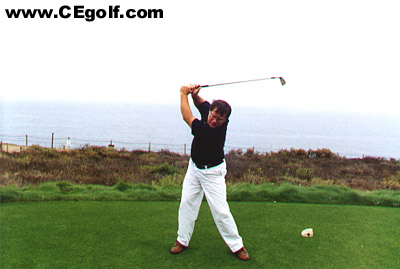
If you're having trouble with the navigaton bar (left), try the CEGolf.com Contents page.
Casey Eberting Golf Instruction
©Copyright 1997-2024, All Rights Reserved